Features of planting roses in summer
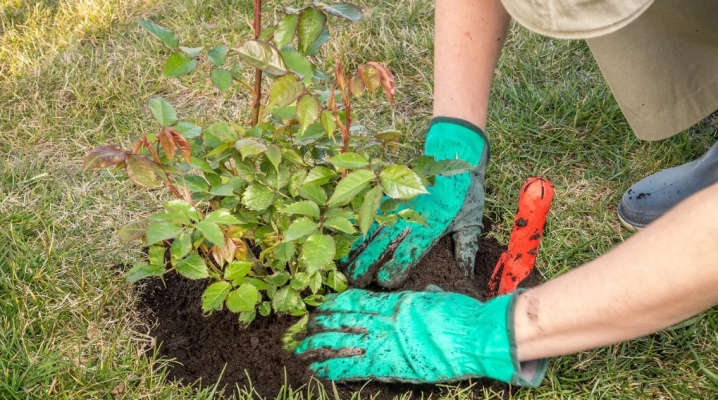
Many gardeners grow a wide variety of crops on their plots. Almost all of them are engaged in growing roses. They have a wonderful delicate aroma, differ in a variety of varieties, shades, and are also unpretentious in care. In order for the culture to please with regular flowering, you need to know how it is planted, whether it is worth planting roses in the summer, and also how to properly care for the bushes.
Landing dates
Growing roses on their site, many gardeners do not always know at what time it is necessary to carry out planting work. It is generally accepted that the best time for this is the spring and autumn period. At the same time, situations often arise when gardeners have to plant roses in the summer.
Summer planting requires special control over soil moisture. With a lack of moisture, a rose planted during this period will simply die. You should not allow an excess of moisture, otherwise the roots may begin to rot.
In the heat, the plant will lose strength to a greater extent than when planted in autumn or spring. This will make rooting progress much slower.
If you have to plant roses in the summer, it is better to carry out work at the beginning of the period, in the month of June, choosing favorable days for this, when the sun is not yet so hot. In July or August, such work is not recommended. In any case, a flower planted in summer will need much more care.

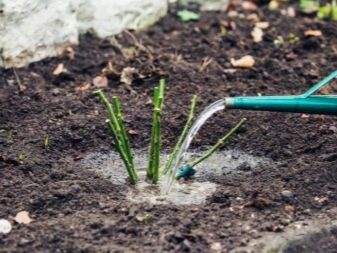
Preparatory activities
Before planting plants in the country or in the garden, preparatory work is carried out. They can be divided into specific stages:
- direct acquisition of plants;
- choosing the most suitable place for them;
- soil preparation.
Quite often, when the word "rose", many people imagine bouquets consisting of hybrid tea varieties. They are also called large-flowered. For hybrid tea varieties, well-lit areas will be preferable, preferably planted on the southeast side. The bushes should be constantly and thoroughly watered, while avoiding waterlogging and stagnation of water. This is done in the evening to avoid sunburn.
In ground cover varieties, the shoots are located at some distance from the roots, creating the appearance of a carpet. This is a very unpretentious variety. Even without special care, the rose will delight with abundant flowering.
When planting a climbing or climbing rose, it is necessary to prepare in advance a support for it, which allows you to set the required direction for growth, as well as support the shrub. It is better to plant a bush and climbing rose in the form of a fence or creating a hedge.
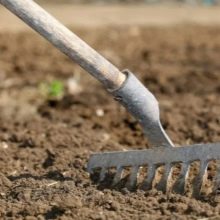
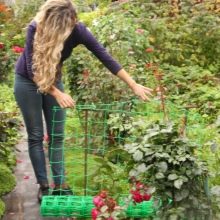

Those gardeners who grow an English rose on their site can boast of the beauty of a blooming garden beauty. Flowers of this variety amaze with the fullness of the flower and the unsurpassed velvet effect. So, certain varieties of the English garden beauty have about 120 petals in one flower.
When choosing seedlings, you should carefully consider the roots. They must be well developed, branched and free from visible defects. When cut, their color should have a light yellow or white tint.
If the roots are closed, it will be difficult to understand how developed they are. In addition, you should make sure that the leaves are green and do not show signs of disease. Quality seedlings usually have two or more shoots.
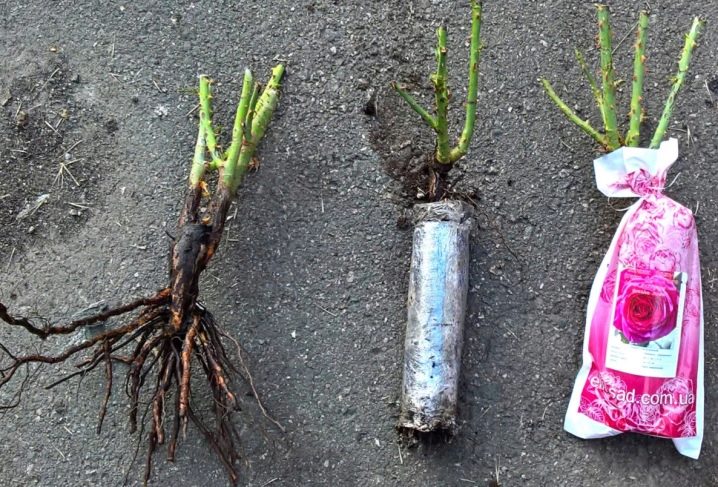
When choosing a place for planting in open ground, take into account that roses will grow well in illuminated areas. Do not forget that excessive midday heat can negatively affect the development of plants, so you should take care of this as well. This is especially important for varieties with dark buds, as they begin to fade under the influence of sunlight.
Besides, it should be remembered that it is better to plant young bushes away from old ones. You should also not choose damp places for this, since this culture does not tolerate dampness. With excessive moisture, yellow leaves with dark spots will begin to appear on the plants.
This crop grows best on fertile, loamy soils, neutral to moderately acidic. If the soil does not meet the above requirements, it is recommended to dilute the soil with sand, humus or peat (in case of clay soil).
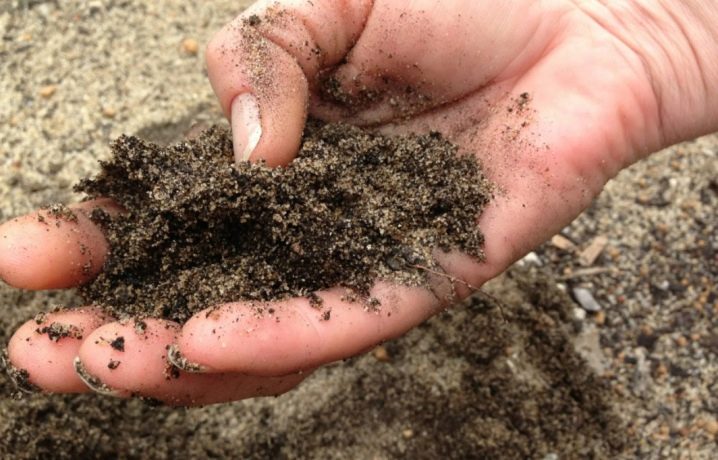
Landing technology
Planting a rose with roots from a container is done according to a certain algorithm. Correctly done work will allow you to hope for high-quality rooting and further plant growth.
Progress:
- Initially, you should prepare a suitable pit. The hole should correspond to the parameters 50x50x50 cm. It is recommended to remove the bottom layer, leaving the top more fertile layer.
- You can improve the composition of the soil by adding superphosphate with sand.
- Planting bushes is done without removing the liner or mesh. Usually, gardeners remove the part of the liner where the roots did not appear. Thanks to such actions, the growth of the flower will be accelerated.
- At the end, the remaining space should be covered with soil in the pit.
- Watering is carried out using a bucket of water. Correct the level by adding soil, then mulch the surface.
With excessively dry and hot days, the sprouts are shaded for 10-15 days.
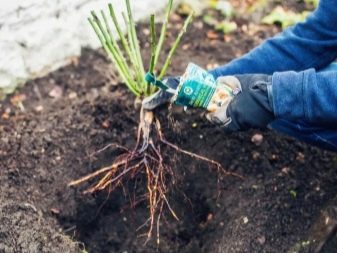
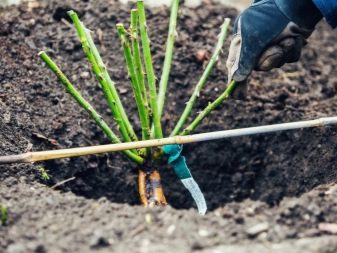
For cultivars with closed root systems supplied in pots, some maintenance is required before planting them in the soil. A sudden move from a pot to a permanent habitat can lead to undesirable consequences. This applies even to unpretentious specimens.
Many people try to grow roses from cuttings by placing them under a jar. Summer is the most suitable time for this. In the event that it was not possible to land during this period, you can do this in the fall.
It should be noted that roses are not amenable to rooting from every bush, so you should pay attention to domestic varieties.
For this:
- take cuttings of cut plants, remove heads, remove thorns;
- then with a sharp knife split the lower part to a depth of 1.5 cm;
- immerse the split in the rooting preparation;
- placed in open ground.
If you want to plant a plant under a jar, you should take cuttings and plant them vertically, without making a slope. In this case, the lower bud should be lowered into well-moistened soil. The upper kidney is left above the ground. Next, place a jar or a plastic container over the pot and leave in this form until several young leaves appear on the cuttings.
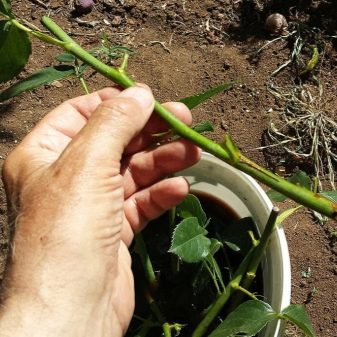
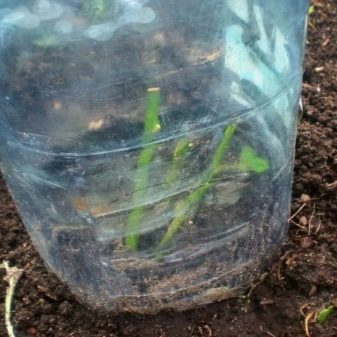
Follow-up care
There are certain rules for caring for seedlings after planting them in open ground.
Watering is done regularly, taking into account weather conditions. The seedlings will be better if they are moistened evenly with a watering can. It is important that moisture can seep into the soil as deeply as possible. Water the flowers in the morning with soft water heated under the sun. Although roses require moisture in summer, excessive moisture can cause powdery mildew or black spot to appear on the leaves.
In 10-15 days after planting, hilling is carried out, followed by covering with mulch to preserve moisture. As mulch, straw, weathered peat, as well as sawdust, bark, and mown grass are suitable. Roses are mulched immediately after watering.
In the presence of yellowish leaves or thin uneven shoots, it is recommended to feed using mineral fertilizers with a weak concentration.
With the beginning of the first flowering, the buds should be cut off, leaving one. This will allow the plant not to waste energy, but to direct them to the development of roots, which in the future will lead to abundant flowering.

Gardening tips
Adhering to the advice of experienced gardeners for planting bushes, many amateurs will be able to grow seedlings with an open root system on their plots.
- When planting them, work should be done carefully, trying not to damage the rhizome.
- It is necessary to inspect the roots in advance, straighten them, if necessary, remove damaged areas or cut unnecessarily long roots. The optimum length for them is considered to be up to 35 cm. Treatment with fungicidal preparations is carried out if there is damage on the roots.
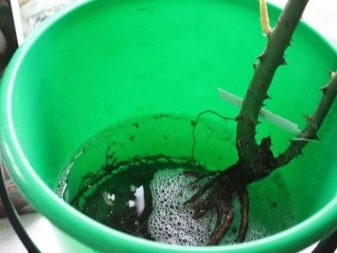
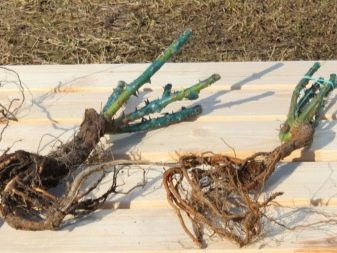

































































































The comment was sent successfully.